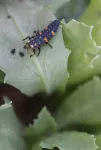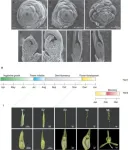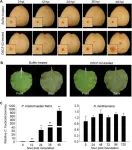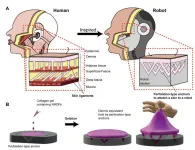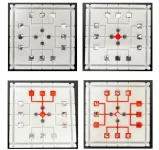(Press-News.org) Leaving some weeds between crops can help to combat pests on agricultural land, according to a new study carried out by the University of Bonn. This step has particularly positive effects in combination with other measures: the cultivation of different types of crops and planting strips of wildflowers. The results have now been published in the Journal of Pest Science.
Intercropping, i.e. planting different types of crops on the same field has a number of benefits: The crops have different requirements and the crops face less competition than when grown in monocultures. This means that they make better use of the water and nutrients and deliver a better yield overall. Some types of crops – such as beans – are also able to fix nitrogen from the air, thereby delivering this nutrient as a natural fertilizer. The other crop also benefits as a result.
“Intercropping also makes it difficult for weeds to grow,” says Prof. Thomas Döring from the Institute of Crop Science and Resource Conservation (INRES) at the University of Bonn. “The crops are also much less infested with pests. Insects usually specialize on one type of plant and they thus find fewer of the right type of plants with intercropping.” While these benefits have been proven many times, Döring and his colleague Dr Séverin Hatt have now investigated whether these benefits can be improved even further in combination with other measures.
Strips of wildflowers attract aphid predators
The researchers cultivated two different crop mixes – beans and wheat and poppy and barley – in a field experiment lasting two years. In addition, they planted strips of wildflowers along the edges of the fields. “These strips attract beneficial insects that feed on pests,” explains Döring, who is also a member of the PhenoRob Cluster of Excellence and the transdisciplinary research area “Sustainable Futures.” “These insects include hoverflies and ladybirds, whose larvae are very effective predators of aphids.”
In fact, the researchers found that aphid colonization of the mixed crops fell significantly next to the wildflower strips. They also discovered another effect: Mixing beans and wheat or poppy and barley naturally suppressed the growth of weeds without actually eradicating them completely. If the farmer took no additional measures, wild plants would continue to randomly grow across the field.
Residual weeds make it easier for beneficial insects to spread
“We have now been able to demonstrate that these residual weeds make it easier for beneficial insects to spread deeper into the field,” says Döring. “And they did not reduce the yield in the process. In contrast, the study showed that they even helped to control pests.” The results were collected from fields that were cultivated under organic farming conditions. The extent to which these findings can be transferred to conventional farming still needs to be investigated.
However, the researchers are already able to issue a clear recommendation for organic farming based on their findings: Farmers should plant wildflower strips, use a greater mix of seeds and consider tolerating some residual weeds. This combination of measures will help them keep pests under control and at the same time maintain weeds at an acceptable level.
Publication: Séverin Hatt, Thomas F. Döring: The interplay of intercropping, wildflower strips and weeds in conservation biological control and productivity; Journal of Pest Science; DOI: https://doi.org/10.1007/s10340-024-01801-1
Media contact:
Prof. Dr. Thomas Döring
Agroecology and Organic Farming
Institute of Crop Science and Resource Conservation (INRES)
University of Bonn
Tel.: +49 (0)228/735143
E-mail: tdoering@uni-bonn.de
END
Farmland weeds help to combat pests
A study from the University of Bonn has investigated how to achieve high crop yields while also protecting the environment
2024-06-25
ELSE PRESS RELEASES FROM THIS DATE:
The American Ornithological Society (AOS) announces its 2024 award winners for achievements in ornithological research by early-career professionals
2024-06-25
CHICAGO — June 25, 2024 — The American Ornithological Society (AOS) annually bestows research awards honoring early-career researchers for their ornithological research. This year’s early-career research awardees represent outstanding contributions to the scientific study and conservation of birds. The 2024 recipients will accept their awards at the 2024 AOS annual meeting (AOS 2024) this October in Estes Park, Colorado.
The AOS’s James G. Cooper Early Professional Award and the Ned K. Johnson Early Investigator Award are presented annually to recognize outstanding and promising ...
From sunspots to traffic jams: Explaining real-world patterns scoops major maths prize for Surrey professor
2024-06-25
A Surrey mathematician is the first ever UK-based winner of a prestigious international prize for his work to better understand patterns which contribute to a diverse range of phenomena, including stop-and-go traffic jams, weather fronts, sunspots and crime hotspots.
The T Brooke Benjamin Prize is awarded every two years by the Society for Industrial and Applied Mathematics (SIAM) – the world's largest applied mathematics society – for outstanding ...
Orchid awakening: Unveiling the hormonal choreography behind flower development
2024-06-25
A cutting-edge study has uncovered the complex hormonal and genetic interactions that dictate the seasonal flowering cycle of Cymbidium sinense, the Chinese orchid. This research sheds light on the enigmatic mechanisms of floral bud dormancy and its subsequent activation, offering new perspectives on the control of flowering times in plants.
Flower development in plants is a complex process influenced by various intrinsic and extrinsic factors. Hormones like gibberellin (GA) and abscisic acid (ABA) play pivotal roles in regulating this process. In many orchids, including the Chinese Cymbidium, flower bud dormancy ...
EMBO Gold Medal awarded to Elvan Böke
2024-06-25
EMBO awards the EMBO Gold Medal 2024 to Elvan Böke, group leader at the Centre for Genomic Regulation (CRG) in Barcelona, Spain. The award recognizes researchers under the age of 40 for outstanding contributions to the life sciences in Europe. The awardee receives a gold medal and a bursary of 10,000 euros.
Early-stage oocytes are exposed to biological and environmental factors for decades, which can make them susceptible to cumulative damage. At the same time, the growth phases associated with oocyte maturation ...
Battling anthracnose: Unearthing the plant's arsenal against pathogenic fungi
2024-06-25
A pivotal study has shed light on the intricate mechanisms of nonhost resistance (NHR) in plants, a critical defense against a broad spectrum of pathogens. By identifying and characterizing four novel core effectors from the pathogen Colletotrichum fructicola, researchers have unveiled key players in the plant Nicotiana benthamiana's immune response. This discovery is set to transform approaches to plant disease management, offering a pathway to bolster crops against devastating fungal infections.
Plant diseases caused by pathogens like Colletotrichum ...
Robots face the future
2024-06-25
Researchers have found a way to bind engineered skin tissue to the complex forms of humanoid robots. This brings with it potential benefits to robotic platforms such as increased mobility, self-healing abilities, embedded sensing capabilities and an increasingly lifelike appearance. Taking inspiration from human skin ligaments, the team, led by Professor Shoji Takeuchi of the University of Tokyo, included special perforations in a robot face, which helped a layer of skin take hold. Their research could be useful in the cosmetics industry and to help train plastic surgeons.
Takeuchi is a pioneer in the field of biohybrid ...
Physical, sexual, and intimate partner violence among transgender and gender-diverse individuals
2024-06-25
About The Study: In this survey study of adults in California, results showed that transgender and gender-diverse individuals, especially transgender men, are at higher risk of experiencing all forms of violence relative to cisgender women. Results highlight the need for gender-affirming violence prevention and intervention services as well as policies that protect transgender and gender-diverse individuals from discriminatory violence.
Corresponding Author: To contact the corresponding author, Sabrina ...
Bone health after exercise alone, GLP-1 receptor agonist treatment, or combination treatment
2024-06-25
About The Study: The combination of exercise and glucagon-like peptide-1 receptor agonist (GLP-1RA) (liraglutide) was the most effective weight loss strategy while preserving bone health in this randomized clinical trial. Liraglutide treatment alone reduced bone mineral density at clinically relevant sites more than exercise alone despite similar weight loss.
Corresponding Author: To contact the corresponding author, Signe Sorensen Torekov, Ph.D., email torekov@sund.ku.dk.
To access the embargoed study: Visit our For The Media website at this link https://media.jamanetwork.com/
(doi:10.1001/jamanetworkopen.2024.16775)
Editor’s Note: Please ...
Penn study finds better survival rates for recipients of lungs from hospital-based donor care units compared to independent donor care units
2024-06-25
PHILADELPHIA— A new study by Penn researchers examined, for the first time, the differences in lung transplant graft outcomes from organs recovered from the two types of deceased organ donor care facilities operating in the United States. The research, published today in JAMA Network Open, offers insights that could improve the organ donation and transplantation process for patients across the nation.
In the U.S., deceased organ donors are traditionally cared for in hospitals, which provide intensive care and testing needed to rehabilitate organs, identify transplant ...
3D-printed chip sensor detects foodborne pathogens for safer products
2024-06-25
WASHINGTON, June 25, 2024 – Every so often, a food product is recalled because of some sort of contamination. For consumers of such products, a recall can trigger doubt in the safety and reliability of what they eat and drink. In many cases, a recall will come too late to keep some people from getting ill.
In spite of the food industry’s efforts to fight pathogens, products are still contaminated and people still get sick. Much of the problem stems from the tools available to screen for harmful pathogens, which are often not effective enough at protecting the public.
In AIP Advances, by AIP Publishing, researchers from Guangdong University of Technology and Pudong ...
LAST 30 PRESS RELEASES:
Shingles vaccine linked to slower biological aging in older adults
A self-assembling shortcut to better organic solar cells
A two-week leap in breeding: Antarctic penguins’ striking climate adaptation
Climate risks to insurance and reinsurance of global supply chains
58% of patients affected by 2022 mpox outbreak report lasting physical symptoms
Golden Gate method enables rapid, fully-synthetic engineering of therapeutically relevant bacteriophages
Polar weather on Jupiter and Saturn hints at the planets’ interior details
Socio-environmental movements: key global guardians of biodiversity amid rising violence
Global warming and CO2 emissions 56 million years ago resulted in massive forest fires and soil erosion
Hidden order in quantum chaos: the pseudogap
Exploring why adapting to the environment is more difficult as people age
Society for Laboratory Automation and Screening welcomes new scientific director: Madeline M. Farley, Ph.D.
Austrian cow shows first case of flexible, multi-purpose tool use in cattle
Human nasal passages defend against the common cold and help determine how sick we get
Research alert: Spreading drug costs over the year may ease financial burden for Medicare cancer patients
Hospital partnership improves follow up scans, decreases long term risk after aortic repair
Layered hydrogen silicane for safe, lightweight, and energy-efficient hydrogen carrier
Observing positronium beam as a quantum matter wave for the first time
IEEE study investigates the effects of pointing error on quantum key distribution systems
Analyzing submerged fault structures to predict future earthquakes in Türkiye
Quantum ‘alchemy’ made feasible with excitons
‘Revoice’ device gives stroke patients their voice back
USF-led study: AI helps reveal global surge in floating algae
New method predicts asthma attacks up to five years in advance
Researchers publish first ever structural engineering manual for bamboo
National poll: Less than half of parents say swearing is never OK for kids
Decades of suffering: Long-term mental health outcomes of Kurdish chemical gas attacks
Interactional dynamics of self-assessment and advice in peer reflection on microteaching
When aging affects the young: Revealing the weight of caregiving on teenagers
Can Canada’s health systems handle increased demand during FIFA World Cup?
[Press-News.org] Farmland weeds help to combat pestsA study from the University of Bonn has investigated how to achieve high crop yields while also protecting the environment
